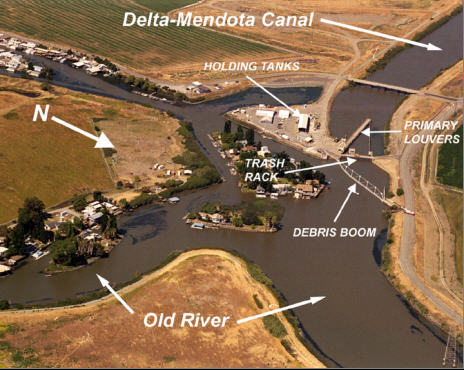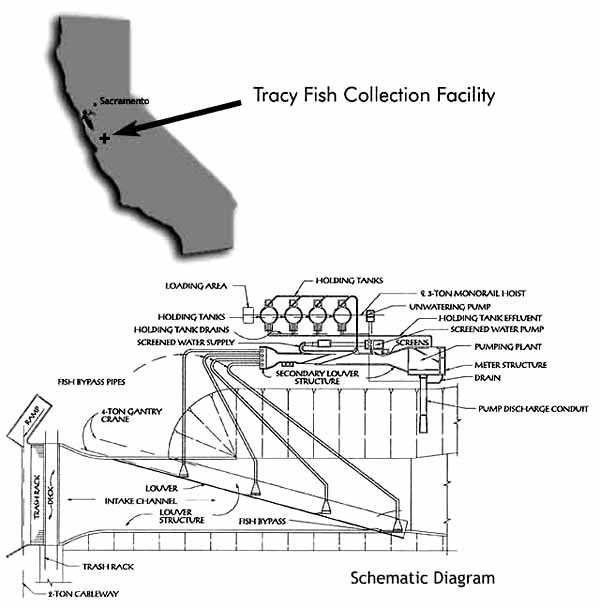- Reclamation
- California-Great Basin
- Programs & Activities
- TFFIP
- Tracy Research Program History
Tracy Research Program History
The Tracy Fish Collection Facility (TFCF)
The Tracy Fish Collection Facility (TFCF), located in the Central Valley of California near Stockton, was developed and built by Reclamation with interagency cooperation in the 1950's as part of the Central Valley Project (CVP). The purpose of the TFCF was to protect fish entering the Delta-Mendota Canal (DMC) by way of the C.W. “Bill” Jones Pumping Plant. These facilities provide multi-use water for the region of the Central Valley called the Sacramento-San Joaquin Delta, or the south delta.


The best available technology in the 1950's proved to be a set of vertical louvers angled into the inflows that directed fish towards recessed collection tanks. Fish are removed from the tanks several times each day, transferred to fish trucks, and transported to lower San Joaquin and Sacramento River sites for stocking.
Initially, the main concern was to rescue (salvage) juvenile striped bass and chinook salmon (below) caught up in the incoming flows of the Delta Mendota Intake Channel.


Louvers proved efficient for these species and sizes if kept clean, although never 100 % efficient.
Many changes have occurred since the 1950's that render the TFCF less desirable as a fish protection facility. These include growing concerns for all Delta fish species, passage of Federal and State endangered species acts, invasion of the Delta by exotic plants and animals that have greatly increased debris loadings, accumulations of fish predators at TFCF, deterioration of physical facilities over time, and increased year round water diversions and pumping rates. Development and operations of the large State facilities at Clifton Court in the 1960's brought additional debris and fish numbers towards the TFCF. Below left is an adult Delta smelt and below right is an adult splittail.


The Tracy Fish Facility Improvement Program (TFFIP)
Reclamation began a Tracy Fish Facility Improvement Program (TFFIP) in 1989 with the overall goal of improving fish protection and fish salvage at TFCF.
TFFIP research is performed in cooperation between the Mid-Pacific Region and research and engineering groups at the Denver Technical Service Center, including the Fisheries and Wildlife Resources Group, 86-68290 and the Hydrologic Investigations and Laboratory Services Group, 86-68560. Research planning and execution is enhanced through coordination, review and assistance from other agencies including the California Departments of Fish and Game (CDFG) and California Department of Water Resources (DWR), U.S. Fish and Wildlife Service (FWS), and the National Marine Fisheries Service (NMFS). Universities, private consultants, and the San Luis Delta Mendota Water Authority also assist.
TFFIP is now identifying and making physical improvements and operational changes, assessing fishery conditions, and monitoring fish salvage operations per 1992 signed agreements with CDFG and legal requirements under the 1992 Central Valley Project Improvement Act (CVPIA).
TFFIP accomplishments to date have included a predator removal program, updated louver efficiency estimates for most species, holding tank surveys, biology and movements of splittail near TFCF, secondary louver netting programs, water quality monitoring, fish egg/larvae entrainment estimates, improved fish handling, more accurate fish identifications, demonstrated abilities for collecting and holding salvaged fish with a “fish friendly” pumping system, and implementation of a “fish friendly” mitten crab removal system (traveling screen).
Facility improvements under TFFIP have included new fish hauling trucks, new louver cleaner rakes, repair of metals in bypasses, new trash racks, replacement of the upstream trash boom, improved instrumentation for monitoring hydraulic conditions, re-surfacing holding tanks with “fish friendly” coatings, development of on-site fisheries labs, development of research level fish holding facilities for biological testing, installation of a demonstration “fish friendly” pumping system with an above ground holding tank, and installation of a large traveling screen for mitten crab removal.
Written by Charles Liston, Ph.D
Tracy Fish Facilities Research Director, 1990-2004
J. Carl Dealy, TFFIP Manager
(209) 836-6236
Last Updated: 11/9/20

